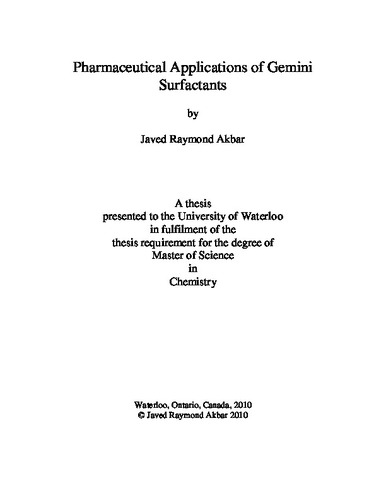| dc.description.abstract | Gemini surfactants are an intriguing class of surface active agents that are comprised of two surfactant monomers chemically linked at or near the headgroups by a rigid or flexible spacer. In comparison to their corresponding monomer counterparts, gemini surfactants are more efficient at reducing surface tension, have better wetting properties, and typically have critical micelle concentration values that are one to two orders of magnitude lower. These intriguing properties characteristic of gemini surfactants make them of special interest for pharmaceutical applications.
Within this work, two different projects were carried out to assess the pharmaceutical applications of gemini surfactants. The aim of the first project was to assess the applications of gemini surfactants as transfection agents for non-viral gene delivery by evaluating the physical stability characteristics of gemini surfactant-based lipoplex systems. Prior to this investigation, an evaluation of the interaction properties between gemini surfactants and DNA, and between gemini surfactants and the neutral helper lipid 1,2-dioleoyl-sn-glycero-3-phosphoethanolamine was carried out using a combination of isothermal titration calorimetry, particle size, zeta potential and surface tension measurements. Following these evaluations, the physical stability of the gemini surfactant-based DNA delivery systems was assessed by examining the particle size distribution and membrane integrity characteristics of the lipoplexes. The results from this analysis revealed that the physical stability of these systems is limited by the membrane integrity characteristics of the lipoplex structure.
The second project carried out was an evaluation of the interactions between gemini surfactants and a series of Tween surfactants commonly found in pharmaceutical formulations. The results from this analysis were analyzed using Clint’s, Rubingh’s, Motomura’s and Maeda’s theories for mixed micelle formation, where it was observed that there is a general synergistic mixing interaction present between gemini and Tween surfactants. The strength of synergism was found to be dependent upon the chain length and saturation of the Tween alkyl tail. | en |

